7 Seconds to Get Inside Your Head: Psychology Behind Billboard Advertising
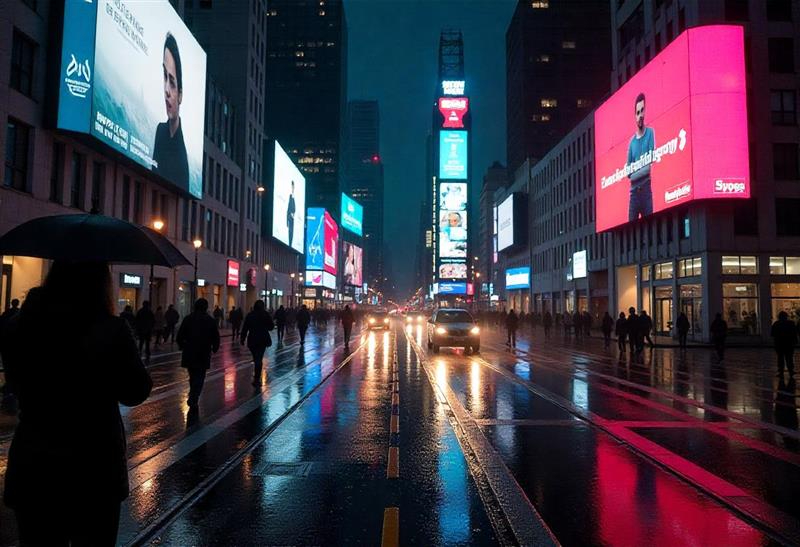
Author – Pooja Kumari
As I drove home, the wind brushed past like a breath on my skin, all I saw through the dim haze were two distant yellow arches.
Just a simple sight.
Back home, some undeniable urge started creeping over.
Just a minute ago, my stomach wasn’t even grumbling, in fact, I wasn’t planning to have dinner. But now I’m hungry. Surprisingly not hungry for salads or home-cooked meals.
Rather, I craved salty fries like a woman possessed.
Is it a game of some psychological intrigue? I wonder. Anyway, I end up ordering Fries, along with McFeast, Hash Browns and Cadbury Creme Egg McFlurry.
So, how does McDonald’s do it? What exactly are they doing? Have they mastered some kind of magic or influenced people’s minds?
See,
Our brains love what’s familiar. For us, humans, predictability is comforting and gradually it builds unshakeable trust. They use this technique of repetitive branding through billboards,
or as Sherlock would quote…
“Observe, if you will, how brands, with but repeated glimpses upon billboards, insidiously lodge themselves in the mind.
A classic case of the Mere-Exposure Effect, Watson!”
Billboards in a Blink: How the Brain Responds in 7 Seconds
Everything is a pattern.
Spot → Decode → Understand → Remember→ React
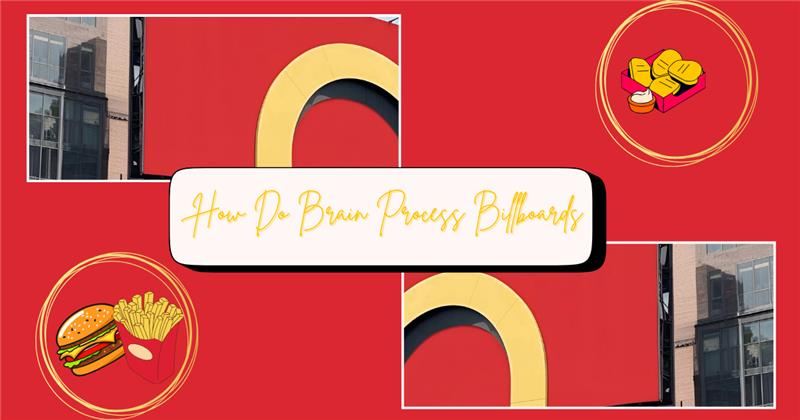
Picture yourself, You’re cruising down the road, lost in thoughts, and suddenly a billboard appears in the distance. What will happen?
Stage 1: Visual Detection (0.1-0.5 seconds)
Your eyes get the first glimpse.
Now, this is what happened,
We are creatures of habit. Our eyes are drawn to familiar paths, such as the ‘Z-pattern’ when reading and the ‘F-pattern’ when scanning.
The occipital lobe then starts processing:
Shapes → Colours → Motion → Contrast
If the billboard stands out, that is, it has bright and bold visuals, your brain grabs it to flag it as important. The prefrontal cortex then briefly engages if something seems important or surprising.
Remember, different eyes detect different billboards differently!
A bold red striking might make a striking impact on an individual. Some might see it as the colour of love, but it signals something far darker and dangerous for others.
For me, it’s always McDonald’s. I’m guilty.
Stage 2: Pattern Recognition & Meaning (0.5-2 seconds)
Once it has registered some information. The recognition process starts. Your brain taps into long-term memory to recognise familiar:
Logos → Texts → Images → Celebrities Related to a Brand
Our ever-watchful, limbic system scans for emotional triggers such as humour, fear and joy.
And then, the prefrontal cortex starts to interpret the message. Oh, that’s McDonald’s!
The brain decodes the core message, ideally the one idea behind the product or call to action.
That’s why it is advised to keep it short and simple, fewer than 7 words work the best, which can be easily read and comprehended.
Stage 3: Emotional & Decision Processing (2-3+ seconds)
When the content hits the right note, it’s engaging or relevant, the amygdala snaps into action and an emotional reaction is evoked.
If the billboard is funny, your brain is flooded with dopamine, a happy hormone. But, if it rubs you the wrong way, something that you don’t like, it triggers anger.
In those fleeting 2-3 seconds, your brain starts evaluating things like:
- “Is it worthy?”
- “Do I actually care about this?”
- “Is this something I’ll remember in five minutes?”
- “Am I gonna end up Googling this at 3 AM in a random panic?”
Stage 4: Memory Encoding (5–7 Seconds)
You must have noted billboards are often repeated in different locations.
The hippocampus starts storing it in short-term memory. Repetition helps consolidate the message and potentially store it in long-term memory if it’s seen often or is especially catchy.
Emotional response boosts memorability, and the desire increases the chances of it being remembered.
The Puppet Strings You Can’t See: Inside the Subconscious Mind
Colour Psychology
The colour of your billboard matters because:
- It is an immediate attention-grabber
- It triggers emotions.
- Some colours are associated with a specific brand.
Experts always advise businesses to use colours either in a creative way or to invoke emotions with the help of a colour wheel.
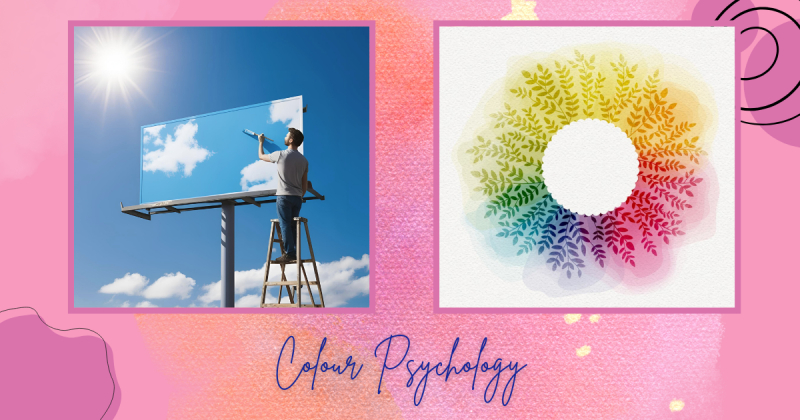
Directional Cues
Directional cues are a great addition to the list. These visuals guide the viewer’s eye.
It’s astonishing that the gaze of the people in the ad can lead you straight to certain parts of the billboard, where probably their call-to-actions are.
Many brands actually edit the pupils of their models and make them dilated, a secret psychological hack, as some research suggests that people are unconsciously drawn to faces with dilated pupils, perceiving them as more attractive or positive.
Familiar Shapes & Logos
Our brains love pattern recognition. It gives us a dopamine hit when we recognise something familiar.
Brands use consistent shapes, logos or silhouettes, just like McD’s The Golden Arches!
Moving Without Motion
You might have noticed some creative billboards use lights, animations and designs that kinda mimic motion, even if static.
Our brain is wired to notice movement. It’s natural and one of our survival instincts. The use of movement in a static image is pure mastery, it gives depth and life to non-living entities.
The “Pop-Out” Effect
Our brains are wired to notice things that break patterns. When something doesn’t match the environment, it screams, “Hey! This might be important, mate!”.
Brands use this technique to make their billboards stand out.
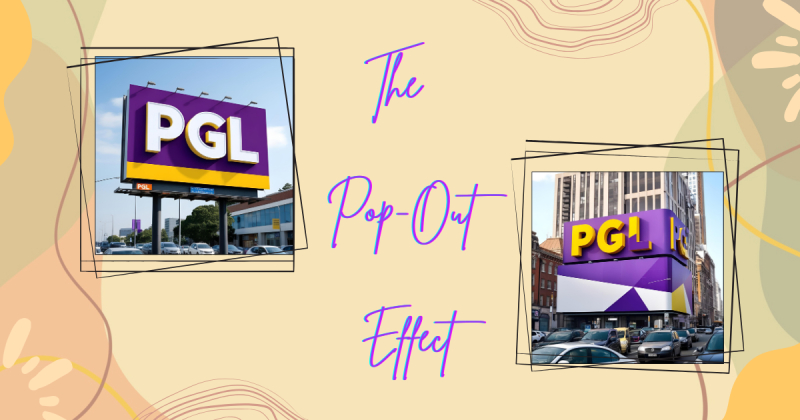
Let’s take a case,
If most billboards in an area are loud, cluttered and text-heavy.
A minimalist, almost empty billboard with one strong symbol or word can feel refreshing, this commands presence.
This is exactly what Apple does masterfully. One product shot. Boom.
Strategic Placement: The Art of Being Seen
Consider sightlines, lighting, dwell time and audience flow. Each choice affects engagement and memory retention.
When it comes to placement it is more than securing a space for your business. The location determines many factors, such as:
- How can people naturally see your brand?
- How does placement affect the way people process your brand’s message?
- How intelligent and creative are you as a brand?
- How serious are you about the minute details?
When advertisers leverage human psychology, they don’t just make sure their billboards are seen but are impossible to ignore and forget, which has the capability of driving people to take action, sometimes without even realising it.
Do not worry, if you’re new to this game. Down below are a few sorted billboard placement strategies, backed by science, that’ll definitely work.
Billboard Gold Zones
- Picking the right spot, where people linger, look or might get stuck in traffic.
- Go for the busy spots. But don’t just throw it anywhere. Your brand has a reputation.
- Keep the message short. 7 words maximum, let the brain do the rest!
- Use visibility that works around the clock.
- Place it smart and then sync it digital.
- Lighting conditions & contrasts: Daylight’s easy, but when the sun goes down, your billboard better be lit.
- Use the new technologies right away: QR codes and geotargeting, because why stop at a billboard when you can extend to online engagement.
Repetition Magic: Billboards That Echo
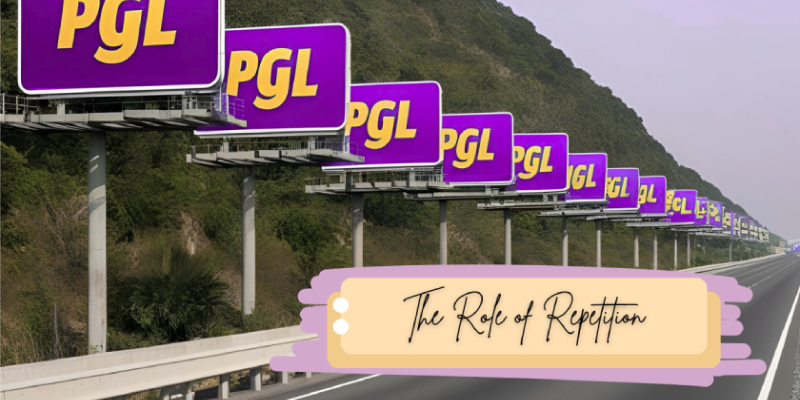
Strengthening Recall
Repetition helps imprint the message in your brain. The more often people see the same visual or phrase, the more likely they are to remember it.
Brand Familiarity
Consistent repetition of logos, slogans or taglines builds familiarity.
Familiar = Trustworthy = More Likely to Convert.
Taglines such as, “Just Do It,” immediately signal your brain, and you recall the brand, “Oh it’s Nike!
Even colours like McDonald’s “red + yellow”. These all are familiar texts and logos that have earned people’s trust, leading to more converts.
Route to Recognition
People often commute the same route daily. Seeing the same billboard repeatedly along that route reinforces the message passively over time.
Dissecting McDonald’s Billboard
Let’s break down the different layers of a billboard and see how our brain interprets it in a matter of a few seconds.
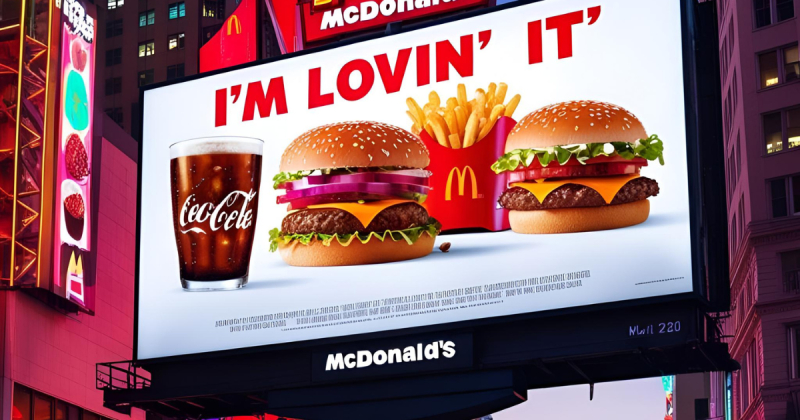
Tagline: “I’m Lovin’ It!”
- Short and Catchy.
- Easy to Read.
- Easy to Remember.
- Easy to digest while driving or walking.
- Emotions: Positive, happy because of the word ‘Lovin’.
Visual Elements: Images & Graphics
- Colour palette: The red and yellow colours are known to stimulate appetite and attract attention. The warmth in yellow and the alertness in the red make it energetic.
- Easily identified from a distance.
- High-quality, close-up shots of their burger, fries and drink. Making it look appetising.
Branding
- McDonalds and its iconic Golden Arches logo which is highly recognisable!
- The billboard is eye-catching because the bright yellow of the Golden Arches logo stands out against the red background.
Typography
- McDonald’s uses bold and easy-to-read fonts in its slogan and promotional text.
- It ensures the text is visible from a distance.
- The text has a very casual font showcasing the accessible and inviting nature of the company.
Placement
- The company chooses the placement of their billboards near highways, busy intersections or close to McDonald’s locations.
- This ensures that their message reaches the right audience and if someone feels like grabbing a bite, they reach as soon as possible.
Target Audience
- It targets people of all ages, especially families, commuters and travellers.
- Their message appeals to a broad group of customers and resonates universally.
- It targets anyone who is looking for a quick, affordable meal.
End of the Road: Conclusion
In the current digital era scenario, billboard advertising games are on fire, and it’s about time to level up. The future billboards will be more interactive and personalised, responding to your mood, location or even the weather, you never know, the possibilities are endless.
Billboards are becoming smarter and more engaging with innovations and new technologies. If a simple abstract billboard can secretly influence your mind in a way that McDonald’s fries are your most urgent craving, then you can’t assume what a smart billboard can do. Now, you’re a part of a game that’s hard to quit.

I am a creative writer, holding a postgraduate degree in English Literature and Language. My sentimentality while crafting beautiful narratives is reflected in my works and speaks of all the academic excellence I’ve achieved.
With years of hard work and patience, I’ve cultivated a sophisticated writing style that intricately weaves together eloquence and intellectual depth. I ensure that each piece of content I pour out leads my readers to explore the art of capturing the complexities of emotions, identity and introspection.
Driven by a desire to explore the nuances of human existence, my literary voice sparks maturity and insight. I always try to find the right balance between evocation and elegance which must leave a lasting mark on my readers.

